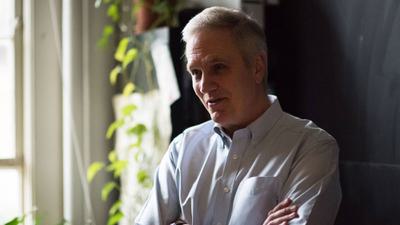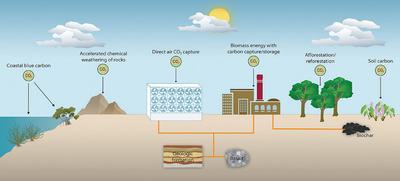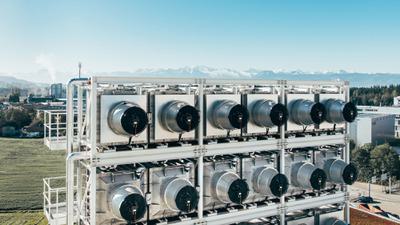Is there still time to avoid runaway climate change? To a large degree, the answer depends on the feasibility of “negative emissions” — techniques or technologies that suck CO2 out of the air. In the latest report from the Intergovernmental Panel on Climate Change (IPCC), all scenarios for limiting warming to 1.5 degrees Celsius depend on negative emissions technologies, or NETs. Most 2-degree scenarios also rely on negative emissions; many call for removing billions of tons of CO2 per year by mid-century.
Yet most NETs remain either untested or unproved. To help bridge this gap, the National Academies convened a panel of scientists and asked it to propose a research agenda. The panel considered several possible techniques, ranging from the low-tech — planting more trees — to the high-tech — developing machines to scrub CO2 from the sky. It also looked at a hybrid technology that has become known as bioenergy with carbon capture and storage, or BECCS. The panel recommended several billion dollars be directed to research on NETs. Such technologies, it suggested, ought to be viewed as a “component of the mitigation portfolio,” rather than as a futuristic, last-ditch effort to reduce atmospheric CO2.
Stephen Pacala, a professor of ecology and evolutionary biology at Princeton University, chaired the panel. In an interview with Yale Environment 360, he talks about why NETs are needed, what should be done to advance them, and why he believes that “direct air capture” technologies could come into widespread use within the next decade.
Yale Environment 360: A couple of years ago, negative emissions weren’t much a subject of discussion, except maybe if you were in the inner world of the IPCC. Now, we’re hearing a lot about them. What has changed?
Stephen Pacala: I think there are three reasons. The first is: humanity keeps procrastinating on mitigation and so it becomes impossible at some point to meet the safe or declared target of limiting temperature increases to 1.5 to 2 degrees [Celsius] without negative emissions. That’s sadly where we are now. To meet the Paris Agreement targets, we need on the order of 10 billion metric tons of negative emissions — 20 percent of today’s annual emissions — by approximately mid-century, and 20 billion tons by century’s end. That’s a lot.
A second reason is that there is renewed interest, in some circles, about land-use options [to reduce CO2 emissions]. In the United States and a few other countries, there is interest in philanthropic foundations in land-use options [such as reforestation and no-till agriculture] that are ready to deliver negative emissions right now. The third reason is that there has been progress in the technical community in industrial versions of negative emissions technologies.
e360: We just saw in the [October 8] IPCC special report on holding temperature increases to 1.5 degrees that all of those pathways contain, to one degree or another, negative emissions. Meanwhile, your report suggests there’s not that much actual work going on right now in this field, that we have a huge research agenda even to determine what’s in the realm of the physically possible. So there seems to be a pretty big disconnect here.
Pacala: Why aren’t we doing more on negative emissions? It’s the same reason that we aren’t doing more of deliberate mitigation. The price on carbon is inadequate, and our decision to solve the problem hasn’t become sufficiently firm yet. As the IPCC’s 1.5-degree report claims, humanity is procrastinating – we have to do a lot more, a lot sooner.
“There has been a revolution in the available technology to solve this problem in the last 15 years with no historical precedent.”
But it’s very important to understand that there has been a revolution in the available technology to solve this problem in the last 15 years with no historical precedent. Fifteen years ago, if you asked me how to solve the carbon and climate problem, I would have said, “I don’t know. We don’t have the technology to do it.” Now when you ask me, I’ll tell you exactly what we have to build as a species to do it.
e360: What are those breakthroughs?
Pacala: First of all, in the last 15 years, wind and solar went from extremely expensive green luxury items maintained by subsidy to the cheapest forms of energy ever. That happened because government subsidized wind and solar, made a market for it that companies competed over, and they relentlessly drove the cost down. It’s a remarkable achievement – that conservatives should relish – of market success, but through government subsidy.
What else happened during the same time? Natural gas, 15 years ago, had an uncertain supply and we didn’t know how to do carbon capture and storage, really. We had done the tiniest bit of it. Since that time, the whole fracking and unconventional gas thing happened. Whether or not you like that, the fact of the matter is that fuel is now super-abundant and would last centuries. Carbon capture and storage has gone from, “Well, maybe it’s possible to do,” to a big business. Sixty-one million tons of CO2 are going into reservoirs and staying there this year in the Lower 48 [U.S. states] alone. That’s a big number.
e360: Your panel looked at techniques like afforestation and better land use, you also looked at enhanced weathering of rock. And you looked at the holy grail, I suppose, which is direct air capture of CO2, where we suck it out of the air and bury it or mineralize it. Where do you see the potential for big breakthroughs here?
Pacala: I think that afforestation, reforestation, changes in forest management, rebuilding the carbon backbone that maintains the fertility in our agricultural soils, and biomass energy with carbon capture and storage using waste biomass can supply material gains.
Negative Emissions Technologies (NETs) range from low-tech, such as planting more trees, to more high-tech options, such as developing machines to scrub CO2 from the air. National Academy of Sciences, 2018
With the direct air capture technologies, 10 years ago you would have said that’s just like a fairy tale. But because of diligent activity by a small number of technical people, there’s been very rapid progress, so much so that knowledgeable people who are not starry-eyed, but just hard-headed, believe that there is a very high probability that a research effort within 10 years would produce direct air capture at less than a dollar a gallon of gasoline. That’s $100 a ton [of captured CO2].
Imagine a scenario where you fly over to Germany and burn aviation gas on the way over, but we have a direct air capture machine that for $100 a ton takes CO2 out of the atmosphere and puts it in the ground to compensate. And the question is, how much did that cleansing of the atmosphere cost in terms of the fuel? The answer is an extra dollar a gallon. So it’s going from say, $2.50 to $3.50 a gallon. Now, aviation biogas, which is the alternative, costs way more than that, and it takes land away from other uses that we need. If you could get [the carbon capture price] down to 50 cents a gallon to solve the carbon and climate problem, how great is that? Our panel thinks direct air capture could be brought into the marketplace in a heavy way within 10 years’ time.
e360: That’s owing to some kind of technological breakthrough, or because we’re just going to bring the cost of these processes down?
Pacala: It’s just cost. It’s an exact analogy to wind and solar. The government should create a market by subsidizing the activity, and then have every super-ambitious person in Silicon Valley who wants to save the world and become the richest person in it, compete with every other such person and drive the costs relentlessly down, and we’ll all be the beneficiaries.
“The ongoing denials of the science, particularly in Republican Party circles, are just something that true conservatives wouldn’t condone.”
I don’t expect to be surprised with direct air capture, because I think that direct air capture developers will succeed. If there’s a surprise, it’s in the enhanced mineralization area. Underneath our feet are minerals, and because they’ve never been exposed to the atmosphere, they are in a state that would spontaneously bind CO2 and turn it into carbonate minerals: rocks. How much of this rock is there? It’s hard to measure exactly, but some estimates say that something like 1,000 times the amount exists that would be necessary. So we’ve got this resource beneath our feet that we haven’t even known was a resource. Haven’t mapped it, haven’t tried to access it.
e360: One of the points that you also make in the report is that sometimes direct air capture has been put under this rubric of geoengineering, and the report tries to disentangle that. What is the difference between some of these negative emissions technologies and geoengineering?
Pacala: The difference between negative emissions technologies and geoengineering is that negative emissions technologies solve the root cause of the climate problem — too much CO2 in the atmosphere. It simply takes out that CO2. Geoengineering says, “Oh, that CO2 in the atmosphere is changing the climate, so let me try to change the climate in compensating ways, like by injecting sulfate aerosols high in the atmosphere to intersect some of the sunlight to cool the planet down.” The problem is, of course, that we can’t compensate exactly for the C02, so we create other problems when we do that. Moreover, if you keep putting more and more CO2 in the atmosphere, you have to keep adding these geoengineering compounds to the atmosphere to compensate. It’s very much the difference between solving the root cause and trying to compensate for symptoms.
e360: Another point the report makes is that the Trump administration is in the process of revoking the Clean Power Plan, of pulling back on vehicle fuel efficiency standards. This seems like another disconnect.
Pacala: Well, the U.S. is of course a very special case right now internationally. It has decided to take a non-evidence based approach to dealing with the climate problem, and it’s something that in my view is a national disgrace. It’s something that we are going to end up correcting as a people. The ongoing denials of the science, particularly in Republican Party circles, are just something that true conservatives wouldn’t condone. Business people make evidence-based decisions — they have to or they don’t survive.
“I would have bet a large amount of money 20 years ago… that there wouldn’t have been enough [CO2] storage capacity, but now I think there is.”
Now let’s look at the flip side. As I said, there are now the technologies available to solve the carbon and climate problem. We have wind and solar, natural gas with carbon capture and storage, and electric cars.
Now, in the [2017] tax bill, an entirely Republican bill, they retained subsidies on wind and solar that are 1.9 and 2.3 cents per kilowatt hour, and they retained a $7,500 tax credit on buying an electric car. Then, last February, a bipartisan act created a $50-per-ton tax credit for carbon capture and storage. That means that the Republican Congress passed subsidies for the entire enchilada. I think it’s very interesting to contemplate why it is that on the one hand we have this political rhetoric, and on the other hand we have this subsidizing of the alternatives.
e360: One of your other challenges was looking at CO2 storage capacity. If we actually put in place a lot of bioenergy with carbon capture and storage, a lot of fossil fuels with carbon capture and storage, and a lot of direct air capture, the CO2 has to go somewhere. Do we have storage problems?
Pacala: It looks like it’s not a problem. I would have bet a large amount of money 20 years ago, when I first started directing a group that works on this problem at Princeton, that there wouldn’t have been enough storage capacity, but now I think there is. It just turns out that there’s a lot, like injection of CO2 into saline aquifers, which is a kind of formation of salty water deep down under the ground. It’s where you get oil and gas from. Now there are some pretty strong indications that CO2 inside the salt reacts and turns into rocks really quickly. One of the things the report calls for is large-scale injection into the salt.
A direct air capture facility in Zurich, created by the Swiss-based technology company ClimeWorks. Julia Dunlop / ClimeWorks
e360: Have you gotten any response from Congress or from agencies to the report?
Pacala: It’s a difficult period because you’ve got a Congress that when we released the report was in Republican hands, and now it’s split. When I talk to conservatives, many of them acknowledge privately the gravity of the climate problem. The question is, what is a conservative rationale? One is that it’s simply competitive. If you took the energy system that I keep harping on, the one we have available now that would solve the carbon and climate problem, and asked, “Which country in the world is best equipped for that sort of an energy system? Which would gain, relative to all others?” The answer is the United States. The U.S. has the natural gas, has the fantastic [CO2 storage] reservoir capacity, the pipeline infrastructure, has tremendous lands for wind and solar. We’ve got all of it. And so we could become the, or one of the, energy superpowers of the world.
e360: One of the objections to even talking about negative emissions has been the moral hazard question, the fear that people will say, “Let’s party now because sometime in the future we’re going to be able to take this all out of the air.” What would your response to that be?
Pacala: There are two responses. The first is that most people who say that also know that the claim that we can wait is not made in any seriousness because we don’t have enough negative emissions technologies to do even 10 or 20 percent of the job. And the moral hazard argument itself creates a moral hazard that is even more serious. So a technical group like the one that I chaired would have to decide that this is too dangerous for the public to know, that they can’t be trusted to make their own decisions, that we have to keep this information and ability from them. That strikes me as a road to ruin. That’s a real moral hazard.





